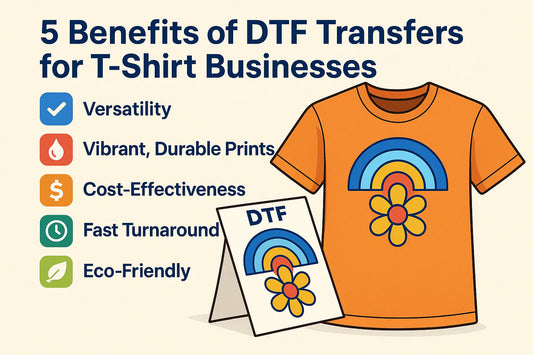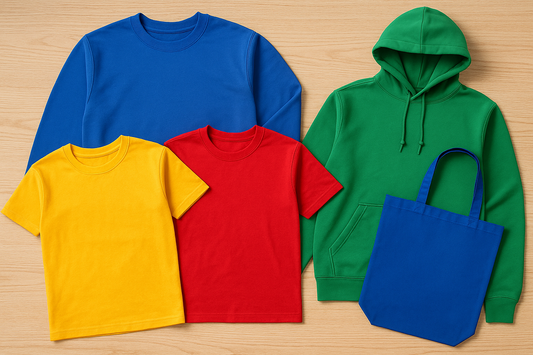Excellent print made t-shirts for some teachers.

Revolutionizing the Textile Industry: An In-Depth Look at DTF Transfers and Their Impact
Introduction
Direct to Film (DTF) transfers have transformed the textile printing industry by providing high-quality, durable, and vibrant prints on a variety of materials. This technology has enabled textile professionals, fashion designers, and small business owners to create intricate designs with ease and efficiency. In this article, we explore DTF transfers in detail, including their advantages, challenges, and real-world applications.
Understanding DTF Transfers: How It Works
DTF printing involves a multi-step process that results in high-quality, full-color transfers applied to fabrics using heat and pressure. Here’s a step-by-step breakdown:
✔ Design Preparation: The artwork is created in a digital format using software like Adobe Illustrator or CorelDRAW.
✔ Printing onto Film: The design is printed onto a special PET film using a DTF printer with pigment-based ink.
✔ Powder Application: A specialized adhesive powder is applied to the wet ink.
✔ Curing: The film is heated to bond the powder with the ink.
✔ Heat Press Transfer: The cured film is placed on fabric and pressed with heat and pressure to transfer the design.
✔ Peeling & Final Touches: After cooling, the film is peeled away, leaving a durable and vibrant print.
Pros and Cons of DTF Transfers
Pros
✅ High-Quality Prints: Produces vibrant, full-color designs with sharp details.
✅ Versatility: Works on various fabrics, including cotton, polyester, blends, and even leather.
✅ No Weeding Required: Unlike vinyl, DTF eliminates the need for tedious weeding.
✅ Cost-Effective for Small Runs: Ideal for businesses producing custom or on-demand apparel.
✅ Durability: Prints are resistant to cracking, peeling, and fading after multiple washes.
Cons
⚠ Initial Equipment Investment: A professional DTF printer and heat press can be expensive.
⚠ Learning Curve: The process requires training to perfect print quality and adhesion.
⚠ Powder Handling: Adhesive powder can be messy and requires proper ventilation.
⚠ Maintenance: Regular printer maintenance is necessary to prevent clogs and ensure longevity.
Real-World Insights: User Reviews & Experiences
To better understand the impact of DTF transfers, we gathered insights from real users across platforms like Reddit and Trustpilot:
🔹 “DTF prints are incredibly detailed and vibrant. Even after 20+ washes, they look as good as new!” – Reddit User
🔹 “The initial investment was high, but I’ve recovered costs quickly through bulk orders.” – Trustpilot Reviewer
🔹 “There’s a learning curve, but once you master it, you’ll never go back to other printing methods.” – Small Business Owner
|
Feature |
DTF Printing |
Screen Printing |
Heat Transfer Vinyl (HTV) |
Sublimation |
|
Fabric Compatibility |
Cotton, polyester, blends, leather |
Primarily cotton |
Cotton, polyester |
Polyester, light fabrics |
|
Color Vibrancy |
High, full-color spectrum |
High, restricted to a limited color palette per layer |
Medium, limited color options |
High, contingent on light-colored fabrics |
|
Durability |
Excellent |
Highly durable |
Medium |
Excellent |
|
Production Cost |
Economical for low volume production |
Significant initial setup costs for small production runs |
Low |
Moderate |
|
Ease of Use |
Moderately complex |
Requires specialized expertise |
Straightforward |
Straightforward |
Analysis: DTF printing provides an advantageous balance of superior quality and broad versatility.
The Future of DTF Transfers: Market Growth & Trends
According to MarketsandMarkets, the global digital textile printing market is projected to reach $8.8 billion by 2025, with DTF being a key driver of this growth. Factors fueling this trend include:
📈 Rise of E-Commerce & Print-on-Demand: Online stores increasingly use DTF for custom apparel.
🌿 Eco-Friendly Solutions: Companies are developing water-based, non-toxic DTF inks.
🖨 Advancements in Equipment: Faster, high-resolution printers with automated powdering systems are reducing labor costs.
Best Practices for DTF Transfers: Tips for Success
To get the best results from your DTF transfers, follow these expert tips:
✔ Use High-Resolution Artwork: Designs should be at least 300 DPI to ensure sharp prints.
✔ Optimize Printer Settings: Adjust ink flow and curing time to prevent smudging.
✔ Proper Powder Application: Ensure even coverage to improve durability.
✔ Invest in a Good Heat Press: Use consistent pressure and temperature for optimal transfers.
✔ Regular Maintenance: Clean printheads and shake ink bottles to avoid clogging.
Conclusion: Is DTF Printing Right for You?
DTF printing has disrupted the textile industry by offering high-quality, versatile, and cost-effective solutions. While the initial investment and learning curve may pose challenges, the benefits far outweigh the drawbacks for businesses looking to scale their custom apparel operations.
🎯 Who should consider DTF?
✅ Small business owners in custom apparel
✅ Print-on-demand businesses
✅ Fashion brands needing intricate, high-quality prints
📢 With the DTF printer market projected to reach $2.66 billion by 2025, now is the perfect time to adopt this technology!













